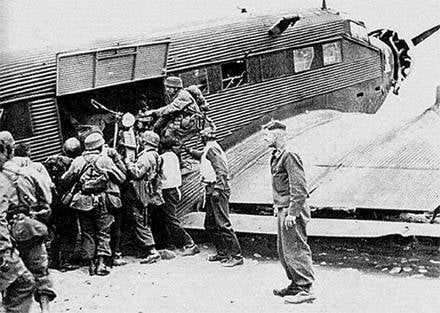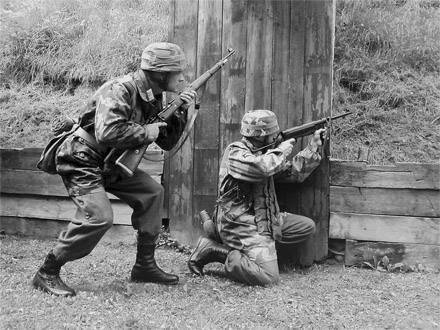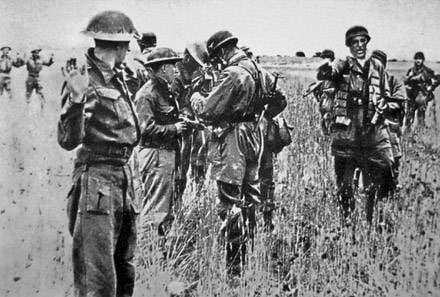Sunset "Mercury"
In many ways, the great losses of the attackers were caused by underestimation of the enemy. The Abwehr believed that the entire British Expeditionary Force (BEC) was evacuated from Greece to Africa, in fact, more than half of it remained in Crete. Intelligence estimated the island’s garrison at 15 000 people, but in reality it was almost three times larger. Under the command of the island’s defense commander, General Bernard Freiberg, there were 31 thousand soldiers (BEC), 12 thousand Greeks and part of the mobilized civilian population of Crete.
By the time the operation began, British intelligence had the Enigma German cryptographic machine in hand, revealed the codes and was able to read Wehrmacht secret messages. But even this information did not make it easier for the British to defend the island, since in German the “landing” no matter whether sea or air was designated by one word - “Landung”. The military leadership of the “great naval nation” greatly underestimated the capabilities of the airborne forces, and therefore assumed that they would conduct an assault mainly from the sea.

Having information about the landing sites, the defenders were preparing for a hot meeting. All three airfields on the island, which were the main target of the invaders, were strengthened and camouflaged firing points were created. All air defense systems - 50 anti-aircraft guns and 24 searchlights were distributed between the airfields, and were never opened by German intelligence. Anti-aircraft gunners received the strictest order not to open fire on the bombers, to wait for the landing. Freiberg even suggested that all three airdromes be rendered unusable, but this proposal was rejected by a higher command, which considered that the available forces were quite sufficient to repel the landing, and damage to the airfields would interfere with the use of its own aviation. It was the refusal to bring the airfields into disrepair that became the basis of the German victory.
Assault plan
According to the developed German plan, the assault on the island implied the capture of three airfields by forces of the 7th Air Division and a separate airborne assault regiment (about 15 thousand people in total), followed by the transfer to the island of the 22nd Airmobile Division, which worked well in the Netherlands. But with the last hitch came out, they just did not manage to transfer it to Greece. Instead, General Student, commander of the invasion forces, was given everything at hand - 3 regiments of the 5th Mountain Division, 1 reinforced regiment of the 6th Mountain Division, about 700 motorcyclists from the 5th tank divisions and various small parts of only about 14 people. They, along with heavy weapons, were supposed to be delivered to the island by sea and by air, after the airborne troops captured airborne troops.
Three regiments of military transport aviation were involved in support of the operation, but even this number of aircraft was not enough, therefore, the landing was carried out in several stages - 3 invasion waves.
The first wave landed on an island in 7: 00 in the morning on 20 in May and included the “West” grouping: a separate airborne assault regiment of General Mayndl (the target was the seizure of the Maleme airfield) and 3 paramilitary colonel Heydrich (the target was the seizure of Souda Bay and Kaniya, where the English headquarters and the residence of the Greek king were located).
The second wave landed on the 13 of 20 hours in May and included the groupings “Center” and “East” 1 and 2 paramilitary colonels Breuer (target - Heraklion airfield) and Sturm (target - Rethymnon airfield).

After the capture of the first targets of the attack was to begin the third wave of the invasion - the landing of mountain rangers and heavy weapons. From the air, "Operation Mercury" were covered 8-th Air Corps General von Richthofen having 716 combat aircraft: 205 attack aircraft, bombers 228, 119 114 single-engine and twin-engined fighters, 50-62 reconnaissance aircraft and aircraft Italian Air Force.
Invasion
Things at the paratroopers did not work out in the morning. In 5: 50, the air force launched a powerful air strike on the island, but most of the enemy’s disguised positions survived. Yes, and with the release of the position of the Germans went lining, the first Junkers-52 and gliders appeared over the battlefield only half an hour after the bombing, when the enemy had already fully recovered and met the paratroopers fully armed.
Dense fire from the ground turned the gliders with the paratroopers into a sieve, many of them, trying to get out of the fire, broke on the rocks or falling into the sea. Trouble paratroopers added and the fact that they jumped without weapons, which was dumped separately in containers. Many paratroopers had with them only a pistol, knife, sapper shovels and 4 grenades and died when trying to get close to containers with weapons. Even in such conditions, dismounted paratroopers attacked the enemy, but it was not possible to capture the airfield Maleme on the move.
The Germans suffered significant losses in the landed first company of Captain Altman after an hour of battle from the 108 left 28 people. The 1 company suffered the same heavy losses, which landed on the artillery positions at the aerodrome and was able to capture 60 lives for them. The 4 Company and the battalion headquarters were virtually completely destroyed as they landed on the positions of the New Zealand infantry. 3-I company of the first wave of the invasion from the airborne assault regiment was able to destroy the air defense battery in the area of the airfield, reducing the loss of aircraft directly during the landing to a minimum. In the future, the Germans used the captured anti-aircraft guns to destroy the convoys rushing to the airfield with reinforcements and occupied the all-round defense.
During the landing, the regiment commander General Meindl was wounded, and the 3 battalion was completely destroyed upon landing. And yet, the paratroopers were able to cling to the northern edge of the airfield, the battles in this area did not subside all day.
The 3 paradigm of the 7 Air Division, which was supposed to capture the Souda Bay and the city of Kania, was not well organized. Even before the landing, the regimental headquarters and the commander of the 7 Air Division, General Süssmann, died (the glider with them because of pilot error crashed into the sea while still at sea). Several paratrooper units were mistakenly dropped over the mountains and soldiers with fractures were put out of action before the battle with the enemy, the 13-I mortar company was thrown over the reservoir and sank in full force.

Headquarters of the Student, seeing that only 500 from the 7 involved in the delivery of the first wave of the landing force did not return, decided to land the second wave. And the morning again repeated story and the shelves, dropped over the airfields of Rethymnon and Heraklion, saved only the night from complete destruction. So 2 pdp Colonel Sturm lost by the evening 400 people killed, and Sturm himself was captured. But even in spite of such difficulties, the role of these landings was important, failing to capture the airfields of the “Center” and “Vostok” groups forged around themselves about 15 thousands of English soldiers.
By the evening of the first day, the position of the paratroopers on Crete was catastrophic, of the 10 000 of the paratroopers who landed in the ranks, there were about 6 thousands left, none of the goals set were fulfilled. It was in this critical situation, when physical forces and ammunition were running out, many commanders were killed and wounded, and there was no connection with Athens, the specificity of the training for the Goering Green Devils, especially for junior and middle managers, had an effect. Dedicated to the overall plan of the operation, the commanders of the paratroopers, independently of each other, created a large number of scattered active centers of resistance, imposing the battle on many times superior to the enemy, not allowing to maneuver, hoping that someone from the neighbors would be able to seize suitable sites for receiving assistance.
Already 21 in May, the Germans transferred the vector of operations only to the site of the “West” group, using all the available parachutists' reserves here. And the paratroopers still managed to discourage Maleme’s runway from the British, although the latter freely swept the entire airfield from the nearest heights. After capturing the band, General Student decided to land 3 waves of troops, mountain rangers, even though the planes would have to land under heavy enemy fire. For two days, the 600 airplanes were destroyed at the airfield of 150 meters in length. But the gates to the island opened, all the huntsmen and heavy weapons arriving on the island and tipped the scales in favor of the German. And so the tragic start of the operation ended in victory, the island of Crete was completely captured by the Axis forces on June 1.
Losses
The British managed to evacuate only about 14 thousands of their soldiers from the island, the defenders of Crete lost almost 4 thousand killed, 3 thousand wounded, 17 thousand people captured. German aircraft shot down an 33 aircraft and sank the 4 cruisers, 6 destroyers, 1 minesweepers and around 11 various small vessels.
The Germans themselves estimated the losses in 3,7 thousand killed and about 2,5 thousand wounded. After the war, these figures were revised upwards. Thus, according to a number of experts, the Wehrmacht lost up to 7-8 thousand people only killed in this operation. Luftwaffe lost in the sky over the island - 271 plane.
- Yuferev Sergey
- http://topwar.ru"rel =" nofollow ">http://topwar.ru
Information